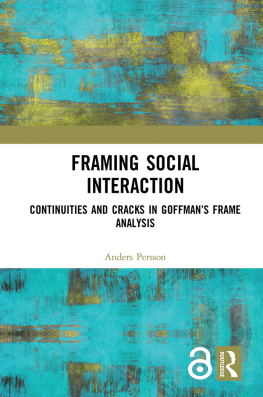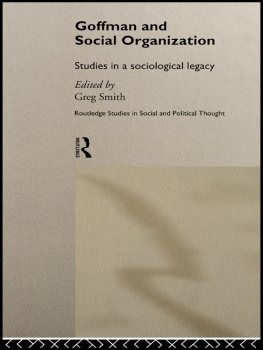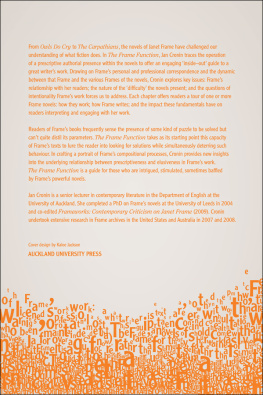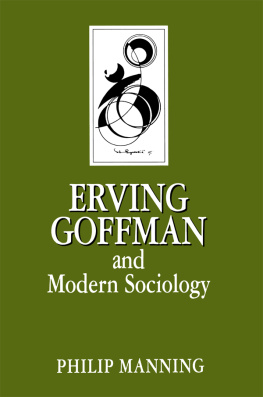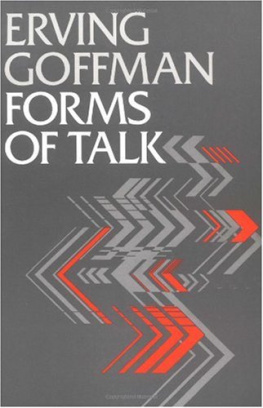Framing Social Interaction
This book is about Erving Goffmans frame analysis as it, on the one hand, was presented in his 1974 book Frame Analysis and, on the other, was actually conducted in a number of preceding substantial analyses of different aspects of social interaction, such as face-work, impression management, fun in games, behaviour in public places, and stigmatisation. There was, in other words, a frame analytic continuity in Goffmans work. In an article published after his death in 1982, Goffman also maintained that he, throughout his career, had been studying the same object: the interaction order. In this book, the author states that Goffman also applied an overarching perspective on social interaction: the dynamic relation between ritualisation, vulnerability, and working consensus. However, there were also cracks in Goffmans work and one is shown here with reference to the leading question in Frame Analysis what is it thats going on here? While framed on a microsocial level, that question ties in with the interaction order and frame analysis as a method. If, however, it is framed on a societal level, it mirrors metareflective and metasocial manifestations of changes and unrest in the interaction order that, in some ways, herald the emphasis on contingency, uncertainty and risk in later sociology. Through analyses of social media as a possible new interaction order where frame disputes are frequent and of interactional power, the applicability of Goffmans frame analysis is illustrated. As such, this book will appeal to scholars and students of social theory, classical sociology, and social interaction.
Anders Persson is Professor of Sociology and Educational Sciences respectively at Lund University, Sweden.
First published 2019
by Routledge
2 Park Square, Milton Park, Abingdon, Oxon OX14 4RN
and by Routledge
711 Third Avenue, New York, NY 10017
Routledge is an imprint of the Taylor & Francis Group, an informa business
2019 Anders Persson
The right of Anders Persson to be identified as author of this work has been asserted by him in accordance with sections 77 and 78 of the Copyright, Designs and Patents Act 1988.
All rights reserved. No part of this book may be reprinted or reproduced or utilised in any form or by any electronic, mechanical, or other means, now known or hereafter invented, including photocopying and recording, or in any information storage or retrieval system, without permission in writing from the publishers.
The Open Access version of this book, available at www.taylorfrancis.com, has been made available under a Creative Commons Attribution-Non Commercial-No Derivatives 4.0 license.
Trademark notice: Product or corporate names may be trademarks or registered trademarks, and are used only for identification and explanation without intent to infringe.
British Library Cataloguing-in-Publication Data
A catalogue record for this book is available from the British Library
Library of Congress Cataloguing-in-Publication Data
A catalog record has been requested for this book
ISBN: 978-1-4724-8258-7 (hbk)
ISBN: 978-1-315-58293-1 (ebk)
Typeset in Times New Roman
by codeMantra
This book was translated by Lena Olsson, with the exception of chapter seven.
Parts of this book have been adapted and translated from Ritualisering och srbarhet: ansikte mot ansikte med Goffmans perspektiv p social interaction by Anders Persson Liber, 2012.
The Canadian-American sociologist Erving Goffman (192282) studied social interaction in a society where old-fashioned customs encountered modernising forces that were transforming political life, working life, everyday life, and other lives. He defended his doctoral dissertation in 1953. In the speech he would have delivered as president of the American Sociological Association at the 1982 congress had he not been prevented by illness, Goffman referred to the interaction order that he had investigated. This interaction order changed a great deal during the thirty years that Goffman was active, but much of what was valid at the beginning of this period was still valid at its close. During the thirty-five years that have passed since Goffmans death, the interaction order has presumably changed to a greater extent than earlier, at any rate in certain parts of the world; e.g., when it comes to relationships between young and old, men and women, authorities and others. What we call globalisation has resulted in the spread not only of goods, food dishes, labour, the market economy, refugees, traditions, illnesses, Western democracy, Islamist terror, identities, models of organisation, military activities for policing the world, bed bugs, music styles, and consumption goods, but also of different ways of interacting socially. Furthermore, new media in particular mobile phones, the Internet, and social media have exposed the interaction order to a transformational pressure, in that spatial proximity is no longer a prerequisite for social interaction. Many societies have thus come to be meeting places for hyper-modern forms of social interaction and old-fashioned social customs, which sometimes leads to conflict but is also most likely handled in precisely the smooth way that Goffman felt characterised the interaction order. Quite a few of Goffmans texts feel dated, not least because of a language that was then completely normal but which has later been transformed in many ways. However, his substantial analyses are amazingly vital and can be applied to current social phenomena, something I will illustrate in this book by exploring in depth Goffmans frame concept and frame analyses.
Ever since I became seriously interested in Goffmans sociology twenty-five years ago, his texts have stimulated my own research on schools, power, education, politics, and social interaction. In 2012 I published a comprehensive book (448 pages) in Swedish: Ritualisation and Vulnerability Face to Face with Goffmans Perspective on Social Interaction (Persson, 2012b), a book that aims both to introduce Goffmans sociology and to study certain aspects of it closer, among other things Goffmans frame perspective as it is presented in his book Frame Analysis. However, Frame Analysis has been a mystery to me since I first became acquainted with it. At first I believed that I myself was the reason why I found the book mysterious, because, among other things, English is not my native tongue, but I then realised that the book was sophisticated, multifaceted, contradictory, and a number of other things. This was probably important in the context, but what finally made me believe that I understood the book was that I began framing Frame Analysis as a book in which a method for studying the many realities of social interaction was developed in a rather praxis-oriented way. This framing has opened a number of opportunities for understanding and using Frame Analysis, which are presented and discussed in the present book. The purpose of this book is to investigate Erving Goffmans frame perspective: both the way it is presented in Frame Analysis from 1974, and as it is practised in Goffmans substantial analyses of frames, in particular those that precede Frame Analysis.
Scholarly research is an activity that develops in interplay and tension between the anchoring in, renewal of, and breaching of traditions, and then both positive and negative influences are of importance. Goffman had fairly little to say about this when it came to his own sociology, but in return there is an extensive body of literature that critically investigates and makes detailed connections between Goffmans sociology and that of others, and that point out a number of different and contradictory influences: Durkheim, Simmel, Freud, Cooley, Parsons, Lorenz, and Hughes. I have chosen another path in this book, but I can assure the reader that I am well acquainted with a significant part of the literature regarding Goffmans sociology. This other path means that I have chosen to study Goffmans entire

